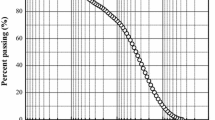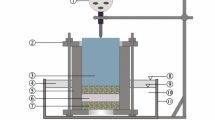Abstract
During the construction and operation of a geological repository, with the infiltration of groundwater, highly compacted bentonite blocks hydrate and swell freely to fill up technological voids and gradually turn to hydrate under a constant-volume condition. Additionally, these processes are inevitably influenced by the pore chemistry of the groundwater. Therefore, it is necessary to investigate the hydration process of compacted bentonite under the combined influences of chemistry and technological voids. In this study, hydration tests were conducted on compacted GMZ bentonite with artificial annular gaps with infiltration of deionized water, 1 M NaCl, and 1 M CaCl2 solutions, respectively. Variation of swelling pressure and hydraulic conductivity with time was measured during hydration. The distribution of dry density, water content, and microstructure feature in the specimens was determined. Results show that sealing of the technological voids resulted in a heterogeneous distribution of dry density and water content of the barrier formed. Compared to that of deionized water, infiltration of salt solutions weakened swelling capacity and increased the permeability, leading to more significant heterogeneity in dry density distribution. During hydration, the specimen could be divided into swelling and compression zones according to variations of dry density with time. The boundary between the swelling and compression zones moved with hydration time. Evolutions of microstructure features were also affected by solutions. For specimens infiltrated with NaCl, more macro-pores and meso-pores were observed, while for CaCl2 infiltration, more undetectable pores and less meso-pore pores could be detected. After the tests, all the specimens were still in non-homogeneous states.















Similar content being viewed by others
References
Akinwunmi B, Hirvi JT, Kasa S, Pakkanen TA (2020) Swelling pressure of Na- and Ca-montmorillonites in saline environments: a molecular dynamics study. Chem Phys 528:110511. https://doi.org/10.1016/j.chemphys.2019.110511
Alonso EE, Romero E, Hoffmann C (2011) Hydromechanical behaviour of compacted granular expansive mixtures: experimental and constitutive study. Géotechnique 61(4):329–344. https://doi.org/10.1680/geot.2011.61.4.329
Berner UR (1992) Evolution of pore water chemistry during degradation of cement in a radioactive waste repository environment. Waste Manage 12:201–219. https://doi.org/10.1016/0956-053X(92)90049-O
Bian X, Cui YJ, Li XZ (2019) Voids effect on the swelling behaviour of compacted bentonite. Géotechnique 69(7):593–605. https://doi.org/10.1680/jgeot.17.P.283
Bradbury MH, Baeyens B (2003) Porewater chemistry in compacted re-saturated MX-80 bentonite. J Contam Hydrol 61:329–338. https://doi.org/10.1016/S0169-7722(02)00125-0
Castellanos E, Villar MV, Romero E, Lloret A, Gens A (2008) Chemical impact on the hydro-mechanical behaviour of high-density FEBEX bentonite. Phys Chem Earth 33:516–526. https://doi.org/10.1016/j.pce.2008.10.056
Chen B, Chen JQ, Cao YC (2012) Influence of joint on self-sealing compacted bentonite in behavior of highly engineering barrier. Chin J Rock Mech Eng 31(3):618–624 (In Chinese)
Chen L, Liu YM, Wang J, Cao SF, Xie JL, Ma LK, Zhao XG, Li YW, Liu J (2014) Investigation of the thermal-hydro-mechanical (THM) behavior of GMZ bentonite in the China-Mock-up test. Eng Geol 172:57–68. https://doi.org/10.1016/j.enggeo.2014.01.008
Cui LY, Ye WM, Wang Q, Chen YG, Chen B, Cui YJ (2019) Investigation on gas migration in saturated bentonite using the residual capillary pressure technique with consideration of temperature. Process Saf Environ Protect 125:269–278. https://doi.org/10.1016/j.psep.2019.03.036
Dauzeres A, Le Bescop P, Sardini P, Cau Dit Coumes C (2010) Physico-chemical investigation of clayey/cement-based materials interaction in the context of geological waste disposal: experimental approach and results. Cem Concr Res 40:1327–1340. https://doi.org/10.1016/j.cemconres.2010.03.015
Delage P, Marcial D, Cui YJ, Ruiz X (2006) Ageing effects in a compacted bentonite: a microstructure approach. Géotechnique 56:291–304. https://doi.org/10.1680/geot.2006.56.5.291
Dixon DA, Gray MN, Hnatiw D (1992) Critical gradients and pressures in dense swelling clays. Can Geotech J 29:1113–1119. https://doi.org/10.1139/t92-129
ENRESA (2000) Full-scale engineered barriers experiment for deep geological repository for high-level radioactive waste in crystalline rock (FEBEX project). EUR 19147, Nuclear Science and Technology Series. Luxembourg, 2000
Fernández AM, Rivas P (2005) Analysis and distribution of waters in the compacted FEBEX bentonite: pore water chemistry and adsorbed water properties. In: Alonso EE, Ledesma A (eds) Advances in Understanding Engineered Clay Barriers: Proceedings of the International Symposium on Large Scale Field Tests in Granite. Taylor & Francis Ltd, pp 257–275
Gens A, Vállejan B, Sánchez M, Imbert C, Villar MV, Van Geetl M (2011) Hydromechanical behaviour of a heterogeneous compacted soil: experimental observations and modelling. Géotechnique 61(5):367–386. https://doi.org/10.1680/geot.SIP11.P.015
Guo YH, Yang TX, Liu SF (2001) Hydrogeological characteristics of Beishan preselected area Gansu province for China’s high-level radioactive waste repository China. Uran Geol 17(3):184–189 (in Chinese)
He Y, Ye WM, Chen YG, Cui YJ (2019) Effects of K+ solutions on swelling behavior of compacted GMZ bentonite. Eng Geol 249:241–248. https://doi.org/10.1016/j.enggeo.2018.12.020
Herbert HJ, Kasbohm J, Sprenger H, Fernandez AM, Reichelt C (2008) Swelling pressures of MX-80 bentonite in solutions of different ionic strength. Phys Chem Earth 33:327–342. https://doi.org/10.1016/j.pce.2008.10.005
Japan Nuclear Cycle Development Institute (2000) H12: Project to establish the scientific and technical basis for HLW disposal in Japan, Project Overview Report. JNC Tech, Rep
Jia LY (2019) The self-sealing properties of technological gaps in compacted GMZ bentonite based barriers of a geological repository. Tongji University (in Chinese)
Jia LY, Chen YG, Ye WM, Cui YJ (2019) Effects of a simulated gap on anisotropic swelling pressure of compacted GMZ bentonite. Eng Geol 248:155–163. https://doi.org/10.1016/j.enggeo.2018.11.018
Johannesson LE, Sandén T, Dueck A (2008) Deep repository – engineered barrier system: wetting and omogenization processes in backfill materials (Laboratory tests for evaluating modeling parameters). SKB Report R-08-136. Swedish Nuclear Fuel and Waste Management Co.
Julina M, Thyagaraj T (2021) Effect of hydraulic gradient on swell and hydraulic response of desiccated expansive soil - an experimental study. Int J Geotech Eng 16:143–157. https://doi.org/10.1080/19386362.2021.1902117
Juvankoski M (2010) Description of basic design for buffer. Posiva Oy, Eurajoki
Kaufhold S, Dohrmann R (2009) Stability of bentonites in salt solutions | sodium chloride. Appl Clay Sci 45:171–177. https://doi.org/10.1016/j.clay.2009.04.011
Komine H, Ogata N (1994) Experimental study on swelling characteristics of compacted bentonite. Can Geotech J 31:478–490. https://doi.org/10.1139/t94-057
Likos WJ, Lu N (2006) Pore-scale analysis of bulk volume change from crystalline interlayer swelling in Na+- and Ca2+-smectite. Clay Clay Min 54:515–528. https://doi.org/10.1346/CCMN.2006.0540412
Luo HW, Ye WM, Wang Q, Chen YG, Chen B (2021) Pore fluid chemistry effects on the swelling behavior of compacted GMZ bentonite with an artificial annular gap. Bull Eng Geol Environ 80:5633–5644. https://doi.org/10.1007/s10064-021-02299-y
MacEwan DMC, Wilson MJ (1980) Interlayer and intercalation complexes of clay minerals. In: Brindley GW, Brown G (eds) Crystal Structures of Clay Minerals and their X-ray Identification. Monograph 5, Mineralogical Society, London, pp 197–248
Meng YH, Wang Q, Su W, Ye WM, Chen YG (2022) Effect of sample thickness on the self-sealing and hydration cracking of compacted bentonite. Eng Geol 307. https://doi.org/10.1016/j.enggeo.2022.106792
Mesri G, Olson RE (1971) Mechanisms controlling the permeability of clays. Clay Clay Min 19:151–158. https://doi.org/10.1346/CCMN.1971.0190303
Mokni N, Barnichon JD (2016) Hydro-mechanical analysis of SEALEX in-situ tests—impact of technological gaps on long term performance of repository seals. Eng Geol 205:81–92. https://doi.org/10.1016/j.enggeo.2016.02.013
Mokni N, Barnichon JD, Dick P, Nguyen TS (2016) Effect of technological macro voids on the performance of compacted bentonite/sand seals for deep geological repositories. Int J Rock Mech Min Sci 88:87–97. https://doi.org/10.1016/j.ijrmms.2016.07.011
Musso G, Morales ER, Gens A, Castellanos E (2003) The role of structure in the chemically induced deformations of FEBEX bentonite. Appl Clay Sci 23:229–237. https://doi.org/10.1016/S0169-1317(03)00107-8
Nuclear Energy Agency (2003) Engineered barrier systems and the safety of deep geological repositories. Organisation for Economic Co-Operation and development, OECD Publications, Paris,France
Pusch R (1982) Mineral–water interactions and their influence on the physical behavior of highly compacted Na bentonite. Can Geotech J 19(3):381–387. https://doi.org/10.1139/t82-041
Pusch R (2001) The microstructure of MX-80 clay with respect to its bulk physical properties under different environmental conditions. SKB Technical Report TR-01-08. Swedish Nuclear Fuel and Waste Management Co
Pusch R, Yong RN (2006) Microstructure of smectite clays and engineering performance. Taylor & Francis, London and New York
Saba S (2013) Hydro-mechanical behaviour of bentonite-sand mixture used as sealing materials in radioactive waste disposal galleries. Université Paris-Est
Saiyouri N, Hicher PY, Tessier D (2000) Microstructural approach and transfer water modelling in highly compacted unsaturated swelling clays. Mech Cohesive-Frict Mater 5:41–60. https://doi.org/10.1002/(SICI)1099-1484(200001)5:1%3C41::AID-CFM75%3E3.0.CO;2-N
Saiyouri N, Tessier D, Hicher PY (2004) Experimental study of swelling in unsaturated compacted clays. Clay Min 39:469–479. https://doi.org/10.1180/0009855043940148
Siddiqua S, Blatz J, Siemens G (2011) Evaluation of the impact of pore fluid chemistry on the hydromechanical behaviour of clay-based sealing materials. Can Geotech J 48:199–213. https://doi.org/10.1139/T10-064
SKB (1999) Waste, repository design and sites. SKB Technical Report TR-99-08. Swedish Nuclear Fuel and Waste Management Co.
Studds PG, Stewart DI, Cousens TW (1998) The effects of salt solutions on the properties of bentonite-sand mixtures. Clay Min 33:651–660. https://doi.org/10.1180/000985598545804
Villar MV, Iglesias RJ, Garcia-Sineriz JL, Lloret A, Huertas F (2020) Physical evolution of a bentonite buffer during 18 years of heating and hydration. Eng Geol 264:105408. https://doi.org/10.1016/j.enggeo.2019.105408
Villar MV, Lloret A (2004) Influence of temperature on the hydro-mechanical behaviour of a compacted bentonite. Appl Clay Sci 26:337–350. https://doi.org/10.1016/j.clay.2003.12.026
Villar MV, Lloret A (2008) Influence of dry density and water content on the swelling of a compacted bentonite. Appl Clay Sci 39:38–49. https://doi.org/10.1016/j.clay.2007.04.007
Wang HK, Qian H, Gao YY (2020) Non-darcian flow in loess at low hydraulic gradient. Eng Geol 267:105483. https://doi.org/10.1016/j.enggeo.2020.105483
Wang Q, Cui YJ, Tang AM, Li XL, Ye WM (2014) Time- and density-dependent microstructure features of compacted bentonite. Soils Found 54:657–666. https://doi.org/10.1016/j.sandf.2014.06.021
Wang Q, Tang AM, Cui YJ, Delage P, Barnichon JD, Ye WM (2013) The effects of technological voids on the hydro-mechanical behaviour of compacted bentonite–sand mixture. Soils Found 53(2):232–245. https://doi.org/10.1016/j.sandf.2013.02.004
Warr L, Berger J (2007) Hydration of bentonite in natural waters: application of “confined volume” wet-cell X-ray diffractometry. Phys Chem Earth 32:247–258. https://doi.org/10.1016/j.pce.2006.02.048
Wen ZJ (2006) Physical property of China’s buffer material for high-level radioactive waste repositories. Chin J Rock Mech Eng 25:794–800
Yang N, Barbour SL (1992) The impact of soil structure and confining stress on the hydraulic conductivity of clays in brine environments. Can Geotech J 29:730–739. https://doi.org/10.1139/t92-081
Ye WM, Chen YG, Chen B, Wang Q, Wang J (2010) Advances on the knowledge of the buffer/backfill properties of heavily-compacted GMZ bentonite. Eng Geol 116:12–20. https://doi.org/10.1016/j.enggeo.2010.06.002
Ye WM, Wan M, Chen B, Chen YG, Cui YJ, Wang J (2013a) Temperature effects on the swelling pressure and saturated hydraulic conductivity of the compacted GMZ01 bentonite. Environ Earth Sci 68:281–288. https://doi.org/10.1007/s12665-012-1738-4
Ye WM, Lai XL, Liu Y, Chen YG, Cui YJ (2013b) Ageing effects on swelling behaviour of compacted GMZ01 bentonite. Nucl Eng Des 265:262–268. https://doi.org/10.1016/j.nucengdes.2013.06.028
Ye WM, Zhang F, Chen B, Chen YG, Wang Q, Cui YJ (2014) Effects of salt solutions on the hydro-mechanical behavior of compacted GMZ01 Bentonite. Environ Earth Sci 72(7):2621–2630. https://doi.org/10.1007/s12665-014-3169-x
Zeng ZX, Cui YJ, Conil N, Talandier J (2020) Effects of technological voids and hydration time on the hydro-mechanical behaviour of compacted bentonite/claystone mixture. Géotechnique 72(1):34–47. https://doi.org/10.1680/jgeot.19.P.220
Zeng ZX, Cui YJ, Talandier J (2021) Long-term effect of water chemistry on the swelling pressure and hydraulic conductivity of compacted claystone/bentonite mixture with technological gaps. Eng Geol 295. https://doi.org/10.1016/j.enggeo.2021.106432
Zhang HY, Wang Y, Ma GL, He DJ, Zhu F (2018) Stress development in compacted block joints backfilled with bentonite powder in HLW barrier. Chin J Rock Mech Eng 37(9):2200–2208 (in Chinese)
Zhang L, Sun DA, Jia D (2016) Shear strength of GMZ07 bentonite and its mixture with sand saturated with saline solution. Appl Clay Sci 132:24–32. https://doi.org/10.1016/j.clay.2016.08.004
Zhu CM, Ye WM, Chen YG, Chen B, Cui YJ (2013) Influence of salt solutions on the swelling pressure and hydraulic conductivity of compacted GMZ01 bentonite. Eng Geol 166:74–80. https://doi.org/10.1016/j.enggeo.2013.09.001
Funding
The financial supports from the National Natural Science Foundation of China (42030714 and 41807237) and the National Key R&D Program of China (2019YFC1509900) are greatly acknowledged.
Author information
Authors and Affiliations
Corresponding author
Additional information
Publisher’s note
Springer Nature remains neutral with regard to jurisdictional claims in published maps and institutional affiliations.
Rights and permissions
Springer Nature or its licensor (e.g. a society or other partner) holds exclusive rights to this article under a publishing agreement with the author(s) or other rightsholder(s); author self-archiving of the accepted manuscript version of this article is solely governed by the terms of such publishing agreement and applicable law.
About this article
Cite this article
Luo, H.W., Ye, W.M., Wang, Q. et al. Pore fluid chemistry effects on homogenization of compacted bentonite specimen with technological voids. Bull Eng Geol Environ 82, 327 (2023). https://doi.org/10.1007/s10064-023-03332-y
Received:
Accepted:
Published:
DOI: https://doi.org/10.1007/s10064-023-03332-y




